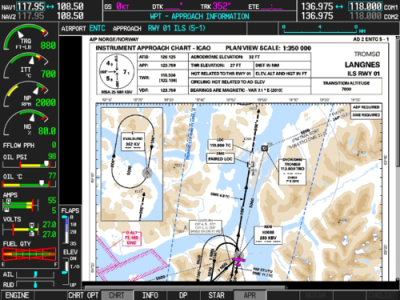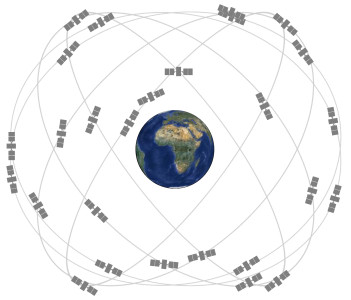Garmin announced last week that they have expanded their global aviation charts to include several additional European countries. This expansion has added instrument approach charts, SIDs, STARs, ground movement charts and airport diagrams. The European FliteCharts expansion is designed to increase pilot awareness and help with approaches by conveniently overlaying the aircraft position onto the chart and providing easy to read charts and information. read more
Using GPS to Create Art at the National Mall

A terresterial portrait, much like Rodriguez-Gerada’s “Expectations” shown above, will soon adorn the National Mall.
GPS technology has seen any number of applications, but starting this month it will be put to an unusual use: creating a six-acre landscape portrait at the National Mall in Washington, D.C.. The project is titled “Out of Many, One” and has been commissioned from Jorge Rodriguez-Gerada, an artist known for large-scale and terrestrial portraits, like the one of President Obama shown above. read more
Boeing Completes Testing on New GPS Satellites
Boeing has completed and shipped six of the 12 GPS 2F satellites to the U.S. Air Force today after on-orbit testing was completed successfully. The 2F satellites are the fourth generation of Boeing-manufactured GPS devices designed to improve GPS signal performance and accuracy worldwide. The United Launch Alliance (ULA) launched the sixth GPS 2F satellite from Florida on May 16, 2014, marking the second launch in three months. The next launch is scheduled for the third quarter of 2014. read more
Garmin BirdsEye aerial imagery now live
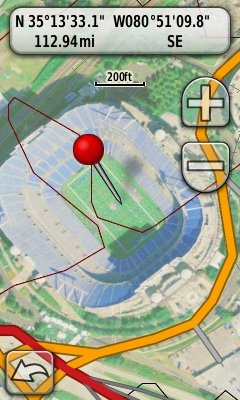 Garmin barely met their March deadline for rolling out BirdsEye aerial imagery. It showed up late yesterday in the form of updates to their BaseCamp software and firmware updates for eligible units — the Colorado and Oregon series; there remains some question about whether both Dakota models are compatible – the Dakota 20 is for sure (more on that below).
Garmin barely met their March deadline for rolling out BirdsEye aerial imagery. It showed up late yesterday in the form of updates to their BaseCamp software and firmware updates for eligible units — the Colorado and Oregon series; there remains some question about whether both Dakota models are compatible – the Dakota 20 is for sure (more on that below).
EDIT: We’ve learned that Garmin decided not to support BirdsEye imagery on the Dakota 10, due to its lack of an expansion card slot.
To get started, run WebUpdater and download or update BaseCamp. Once you start BaseCamp and connect your unit, you should get a message asking if you want to create BirdsEye imagery for your device. You can download a low-resolution demo for free or pony up $29.99 for a year of downloads.
I’m posting a couple of images here. I haven’t used them out in the field yet, but they appear washed out on the screen of my Oregon 400t. The one at left is Panther Stadium in Charlotte; below is a high elevation bald in the Rocky Fork tract, a new 10,000 acre public land acquisition near the NC/TN border. The resolution available for that area does not allow me to pick out forest roads, limiting its usefulness. This is an early test though; other areas may have higher resolution imagery available. In more open terrain (e.g., western US), you might be able to pick out trails and 4WD tracks, even at this resolution.
More on Garmin BirdsEye aerial imagery
 The BirdsEye aerial / satellite imagery subscription program for the Garmin Colorado, Dakota and Oregon series is now official. EDIT: I’ve learned that Garmin decided not to support BirdsEye imagery on the Dakota 10, due to its lack of an expansion card slot. I have a few tidbits to add to my post from last week:
The BirdsEye aerial / satellite imagery subscription program for the Garmin Colorado, Dakota and Oregon series is now official. EDIT: I’ve learned that Garmin decided not to support BirdsEye imagery on the Dakota 10, due to its lack of an expansion card slot. I have a few tidbits to add to my post from last week:
- The $29.99 subscriptions will be available starting this March
- Imagery will include “0.5 meter per pixel resolution in many areas of the United States”
- There is no mention of world-wide imagery in today’s news release, though it was mentioned on the Garmin BirdsEye imagery product page last week, which is unavailable right now
- Another BirdsEye web page has been announced, though it too is currently unavailable
- Image packets will be delivered in multiple resolution levels to avoid pixilation when zooming
- In response to a question, a Garmin PR contact told me “we have nothing to announce re: USGS maps at this time”; my take on that – it’s coming!
Garmin BirdsEye Satellite Imagery coming
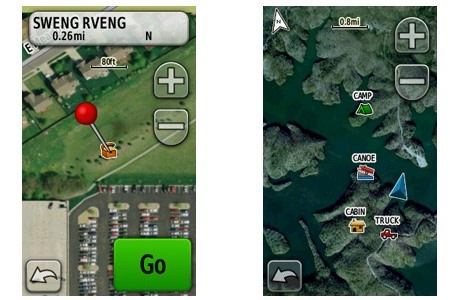 EDIT: I’ve learned that Garmin decided not to support BirdsEye imagery on the Dakota 10, due to its lack of an expansion card slot.
EDIT: I’ve learned that Garmin decided not to support BirdsEye imagery on the Dakota 10, due to its lack of an expansion card slot.
It looks like Garmin is getting ready to announce a BirdsEye satellite imagery subscription program for owners of the Colorado, Dakota and Oregon handheld series. Similar to DeLorme’s Map Library, the BirdsEye program will let you transfer an unlimited amount of satellite imagery and aerial photos to a compatible Garmin handheld for $29.99 per year. Imagery will be locked to one device per subscription; you’ll need Garmin’s free BaseCamp software (version 3.0.0+, yet to be released) and a myGarmin account. I hope to update this post soon with details on when the program will be up and running.
Two new tools for making Garmin custom maps
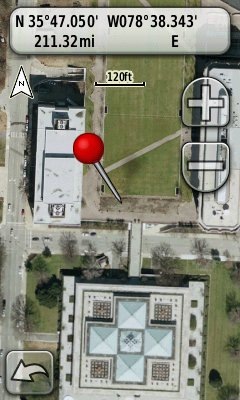 I didn’t think this would take long. Some of the more technically adept GPS enthusiasts among us have put together some great tools for creating custom maps for the latest generation of Garmin handhelds. Here are two new ones released in the last day or so. Both allow you to create maps without manually calibrating them in Google Earth.
I didn’t think this would take long. Some of the more technically adept GPS enthusiasts among us have put together some great tools for creating custom maps for the latest generation of Garmin handhelds. Here are two new ones released in the last day or so. Both allow you to create maps without manually calibrating them in Google Earth.
G-Raster
Created by Lester Pawlowicz of Free Geography Tools, G-Raster allows you to create maps from imagery freely available online. The following formats are supported:
- GeoTIFF
- MrSID
- NOAA BSB (.kap)
- ERDAS (.img)
- USA PhotoMaps Big JPEG
- UTM world file images
- World file images for other coordinate systems
Garmin adds custom raster imagery support to newer handhelds
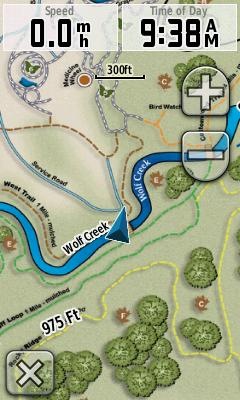 Garmin has added support for custom raster imagery to the Colorado, Dakota and Oregon product lines. This will allow you to add aerial photos, USGS topo maps, etc. to your device. You’ll need the latest beta firmware for the units (betas have not been posted for all units yet), but the process is laid out in this post. Basically, you create an image overlay in Google Earth as a .kmz file and transfer it to your unit.
Garmin has added support for custom raster imagery to the Colorado, Dakota and Oregon product lines. This will allow you to add aerial photos, USGS topo maps, etc. to your device. You’ll need the latest beta firmware for the units (betas have not been posted for all units yet), but the process is laid out in this post. Basically, you create an image overlay in Google Earth as a .kmz file and transfer it to your unit.
I’m heading out into the field later today and will try to load a U.S. Forest Service topo quad, if Garmin posts a beta for the Oregon 400t this morning.
Scott at GPS Fix has more details, including beta firmware links.
UPDATE: Here’s the Oregon 400t beta firmware link and a screenshot from the USFS topo map I did this morning:
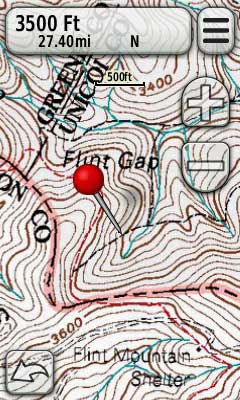
TwoNav Aventura is a lust-worthy GPS
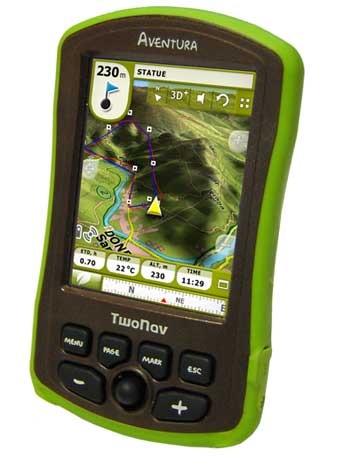 I don’t often write about GPS receivers that aren’t available in the U.S., but I’m making an exception today with the TwoNav Aventura. For one thing, the company is on the lookout for a stateside distributor, so we may see it here yet. Another reason is it will accept just about any kind of map – more on that in a moment. The Aventura is a dual-use device, but it’s the handheld possibilities that excite me, so if you’re an outdoor type, I encourage you to read on.
I don’t often write about GPS receivers that aren’t available in the U.S., but I’m making an exception today with the TwoNav Aventura. For one thing, the company is on the lookout for a stateside distributor, so we may see it here yet. Another reason is it will accept just about any kind of map – more on that in a moment. The Aventura is a dual-use device, but it’s the handheld possibilities that excite me, so if you’re an outdoor type, I encourage you to read on.
TomTom hacks – aerial photos and more
I came across some great TomTom hacks this weekend, including one for aerial photos (or any kind of raster imagery). I haven’t tried any of these out, so you’re kind of on your own here. As always, I’d do a full backup of the unit before trying them. Regardless, these look like some great resources for the TomTom enthusiast:
